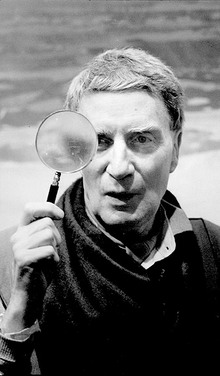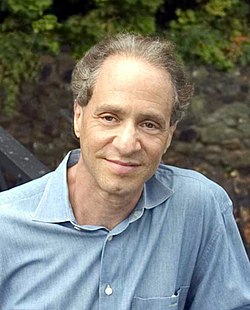Wednesday, October 31, 2012
Brion Gysin
Brion Gysin was a British writer, painter, and performance artist. He created the cut-up poetry technique, used by William Burroughs. Burroughs described him as "the only man I ever respected". He may have been the man to invent weed brownies. Also, he was credited with inventing the dream machine with Ian Somerville. A contributor of the beat generation, he was an influence in music, literature, and art. He died at the age of 70 from lung cancer.
Wednesday, October 24, 2012
Bauhaus and McCarthyism
Bauhaus was a school in Germany that combined crafts and fine arts. It was open from 1919 to 1933. The school was heavily influenced by modernism and an artistic mindset. Many artists were exiled under the early Nazi regime, spreading their art style to many different countries.
McCarthyism was the name for the fear-induced control of public media and propaganda in the 1950's. Thanks to the Cold War and extremely high tensions with Russia, Communism and everything associated with it became taboo. Senator Joseph McCarthy took it upon himself to blacklist many artists in art, music, and film that he suspected to be Communist without any legitimate evidence.
Monday, October 22, 2012
Grid Art
For my grid art project, I picked a background from the popular Super Mario Brothers series. I used M&Ms and a picture frame as my medium, which proved to be more difficult than it looks. Each M&M was individually glued down, giving it a significantly different texture than a computer generated pixelized image. Due to the constraints of the picture frame, I could not make it as large as the original image, but I was able to include every detail necessary (also that red m&m with the m facing up is my own detail, it is meant to signify mario jumping to get to the block). I would have gotten more colors if I had the money. This project resulted in me spending a lot of money and eating a lot of spare M&Ms.


Thursday, October 18, 2012
Steve Jobs vs. Bill Gates Rap Battle (with a special guest)
I pulled a Joe and found something funny on Youtube. Enjoy!
Monday, October 15, 2012
What's with the Apple?
The classic apple logo was chosen for many reasons. First of all, it relates to the tale of Newton discovering gravity when an apple fell on his head. In the first logo, the apple is covered by rainbow colors, but in the wrong order. This gives a sense of creativity. The bite could mean many things: a symbol for lust of knowledge, a reference to Adam and Eve, a computer "byte", or simply to differentiate the logo from looking like a cherry. Overall, the simple logo is easily recognizable all over the world, and will remain so for years to come.
Wednesday, October 10, 2012
Ray Kurzweil
Ray Kurzweil is an American inventor. When Kurzweil was 15, he began his first project involving pattern recognition—teaching machines how to see and understand patterns in information. In high school, Kurzweil began corresponding with Marvin Minsky, an artificial intelligence guru at the Massachusetts Institute of Technology. Kurzweil chose to attend MIT partially because of his relationship with Minsky. There he double-majored in computer science and creative writing.
While he was taking classes, Kurzweil founded a company where he used a computer to match high school students with colleges. He later sold his company to Harcourt for $100,000 plus royalties. In 1970, he completed his BS at MIT and just a few years later he founded Kurzweil Computer Products, a software and hardware company. There Kurzweil and his team invented what would be one of the hallmarks of his entire career—the Kurzweil Reading Machine, which included the first CCD ("charge coupled device") flatbed scanner and first omni-font OCR ("optical character recognition") software. The machine used only 64K of RAM and was able to scan lines of text one at a time. The machine "recognized" each character as it passed regardless of typestyle; corrected the order of the characters in its memory; determined the pronunciation of the resultant words according to pre-programmed phonological rules; and articulated those words through a speech synthesizer, also created by the company.
Monday, October 8, 2012
Fun with Flipbooks
Alright so: This flipbook. Never have I seen so many sharpies, never have I been so literally intoxicated by a school project. Never have I spent so many hours coloring pages solidly, which will be remembered as one of my poorer life choices. As a very artistically-challenged person, I figured it would be better to do a coloring-based project versus something that would require actual drawing. I was so wrong. HOWEVER, I do like the end result and am reasonably proud of it now that it's finished. Many hours were put into this, and it's nice to be able to sit back and watch it move.
Without further ado, here is Over The Rainbow: A Flipbook Project.
Monday, October 1, 2012
Wendy Carlos and A Clockwork Orange
First of all, A Clockwork Orange is one of my favorite books and movies of all time. I love the language, I love the plot, and I love the idea of perspective forcing the reader to feel sympathy for the bad guy. Alex has very few redeeming qualities, but because of getting to hear the story from his perspective we relate to him.
Wendy Carlos (born Walter Carlos) wrote the score for A Clockwork Orange. Her story begins at a very young age, as she composed music and built computers. She was one of Moog's first customers, and used it frequently in her compositions. She studied electronic music at Columbia college. She went on to compose many individual pieces and work on movie scores, including A Clockwork Orange and The Shining. Not only is she an accomplished pioneer of electronic music, she also happens to be a solar eclipse photographer. She is still alive today at age 72.
I find Wendy fascinating, both in personal life and in compositions. Here is Funeral for Queen Mary for ACO:
Subscribe to:
Posts (Atom)




